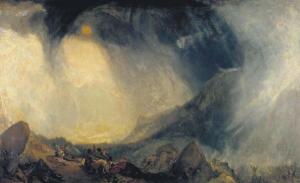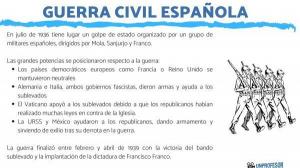Romanesque painting: general characteristics

The Romanesque art It could be said that it is the first international artistic style of Western culture representing a spiritually united Europe, regardless of political divisions. This artistic uniformity chronologically takes place from the beginning of the 10th century to the 13th century. Next, in this lesson from a TEACHER, we will see what the general characteristics of Romanesque painting so that you better know this artistic movement that was carved out in Europe.
Index
- Romanesque painting: place of application
- Most important characteristics of Romanesque painting
- General characteristics of Romanesque painting
- Romanesque painting in Spain
- Romanesque painting in Europe
Romanesque painting: place of application.
We start with the general characteristics of Romanesque painting talking about the places where this type of pictorial art was applied. Romanesque painting, like sculpture, is subordinate to the architectural framework and this will be reflected mainly in the
walls, apses Y vaults of the churches, although we will also see Romanesque painting in manuscripts and on panel.Regarding the manuscripts and miniature books, Romanesque painting acquires great importance, giving the possibility of a full page decoration or by isolated parts, as for example it is in the so-called Book of testaments, which is preserved in the Cathedral of Oviedo and could be considered one of the best examples of Romanesque miniature in Spain. The main objective was to decorate the books, without any didactic intention.
In Spain it is also very characteristic to find this type of painting on board that usually occur especially on the fronts and sides of the altar tables. The arrangement of these fronts is that in the central part appears the Pantocrator, the Virgin or some saint and then on both sides, there are various scenes separated by stripes. As an important example to highlight the front of Aviá dated in the XIII century.
Most important characteristics of Romanesque painting.
Next, we are going to analyze the general characteristics of Romanesque painting, taking into account the technique and iconography of this type of art.
Iconography of Romanesque painting
The topics covered will always be biblical, that is, the Apocalypse (last book of the New Testament) and especially the Majesty Dominis or Pantocrator. Another theme was that of the Tetramorphs, which is the representation of the four evangelists accompanied by their corresponding symbols: Saint Luke (bull), Saint Mark (lion), Saint John (eagle) and Saint Mateo (angel).
Technique
The most used technique is that of fresco Regarding the mural painting of the interiors of the churches and apses, however, the retouching was done with the tempera technique in which the egg was used as a binder. This technique was also used to decorate the fronts of the altar.

General characteristics of Romanesque painting.
Some say that the uniqueness of Romanesque painting derives from the Byzantine mosaic and the Mozarabic miniature, its main contribution being the stylization, hieraticism and silhouetting of figures.
Between his formal characteristics we can specify the following:
- The human figure is going to be reduced to schemes, in order to capture a specific idea.
- Thick drawing line, outlining the figures in black or red.
- Use of spot colors, without mixing.
- Representation of hieratic figures, that is, without movement.
- Lack of depth, that is, without perspective.
- Juxtaposed compositions, that means that many figures will appear together and crowded together.
- The painting is going to be unnatural and full of mysticism.
- Disproportionate anatomy
Romanesque painting in Spain.
We have a large repertoire of Romanesque painting, but they can be divided into two main focuses: Castilla y León and Catalonia.
Catalonia
In Catalonia important Romanesque paintings appeared in the 11th century, using a very peculiar technique, such as the use of fresco retouched in tempera, giving the paintings much more liveliness. This case could be applied in the Martyrdom of Saint Quirce. It is generally very archaic and reminds us of Byzantine painting from the 6th and 7th centuries.
We also have to mention the frescoes of San Clemente and Santa María de Tahull.
Castile and Leon
The Mozarabic miniature, together with more naturalistic nuances, will give rise to a Romanesque painting of greater inspiration and with more narrative capacity and touches of landscape.
The fundamental example is the crypt of San Isidoro de León, whose paintings date from the 12th century, and are six vaults covered with paint where white is used as a plastic element to give volume. Within the characteristic conventionalism, the clothes and faces are treated with an unusual freedom and naturalness and are the result of a more dedicated attention to nature.
In Soria, we find paintings in the church of San Baudelio de Berlanga, characteristic because it does not represent religious themes but hunts.
Finally, in Segovia there are the Maderuelo paintings, which represent scenes from Genesis, where we see themes such as Adam and Eve or Cain and Abel. Today they can be seen in the Prado Museum in Madrid.
Romanesque painting in Europe.
But in France and Italy you can also enjoy the most outstanding Romanesque painting in Europe, for this reason, we briefly stop on these two countries:
France
The great barrel vault of the crypt stands out Saint Savin sur Gartempe, dating from 1200 and all of it is decorated with light and scarce colors: ocher, gray, green, white, black... in the ceiling the Apocalypse stands out, but in the vault the painter has represented many scenes from the Bible. In the crypt the martyrdom of Saint Savin and Saint Cyprian is narrated.
Romanesque painting in Italy
There is a great Byzantine influence, where the paintings look like mosaics made in fresco. The best frescoes in Central Italy at the moment are those of the church of San´t Angelo in Formis, which narrates evangelical and Old Testament scenes.
If you want to read more articles similar to Romanesque painting: general characteristics, we recommend that you enter our category of Story.



